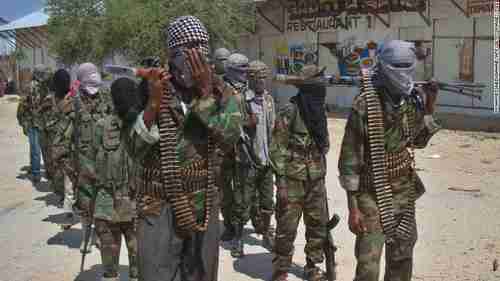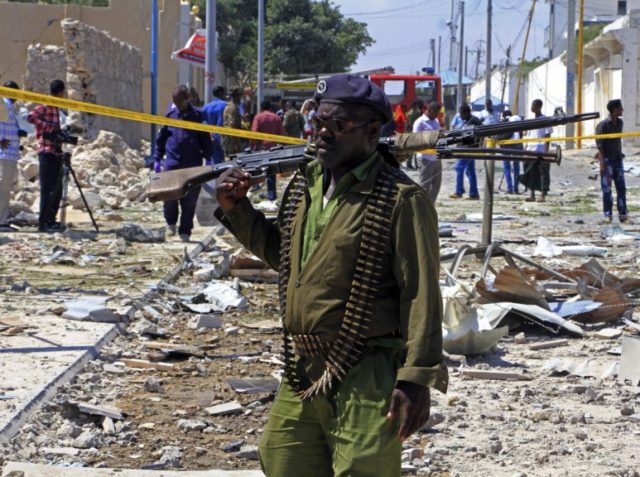This morning’s key headlines from GenerationalDynamics.com
- US sends dozens of troops to Somalia, first time since Black Hawk Down
- Somalia’s civil war and the Black Hawk Down incident
US sends dozens of troops to Somalia, first time since Black Hawk Down

Al-Shabaab fighters
The US is sending dozens of troops to Somalia in order to provide training to Somali forces fighting the al-Qaeda linked Islamist group al-Shabaab.
This is the largest deployment of American troops to the Horn of Africa since American troops were withdrawn in 1994, following the disastrous Black Hawk down incident. In October 1993, a US operation in Mogadishu ended in disaster when two Black Hawk helicopters were shot down, leading to a 15-hour battle that killed hundreds of Somalis and 18 Americans.
About 40 soldiers from the 101st Airborne Division, based in Fort Campbell, Ky, have been sent to Somalia. They will not take part in combat, but will focus on training the Somali army to bolster its logistics capabilities. The Somali government had requested the training, as its war against al-Qaeda based al-Shabaab has been far from decisive. At the same time, the US military is increasing the number of airstrikes against al-Shabaab.
The African Union troops include armies from Kenya and Uganda, but these troops are scheduled to pull out in 2018. The purpose of the US troops is to train the Somalis to fight al-Shabaab on their own, which may or may not be successful. Stars and Stripes and AP and Foreign Policy
Related Articles
- Kenya gets mired in Somalia, and U.S. involvement expands in Ethiopia (29-Oct-2011)
- Somalia’s Al-Shabaab claims responsibility for religion-based Kenya attack (23-Nov-2014)
- Minnesota link to Kenya shopping mall attack raises U.S. fears (23-Sep-2013)
- Kenya’s High Court blocks attempt to close Dadaab refugee camp (10-Feb-2017)
Somalia’s civil war and the Black Hawk Down incident
Somalia’s civil war ran from 1988 to 1994, but the stage was set decades earlier by the rise of Mohamed Siad Barre, who seized power in 1969 and set up a brutal Marxist totalitarian dictatorship. Siad tried to unify the local clans, but in the end the clans destroyed him and his totalitarian state.
In 1977, next-door-neighbor Ethiopia was in chaos, at the start of a full-scale generational crisis war with Eritrea. Siad tried to take advantage of the chaos by attacking Ogaden, a large region of Ethiopia on Somalia’s border, populated mostly by Somalis. Siad had hoped to get the backing of his pals in the Soviet Union, but they betrayed him and sided with Ethiopia.
The result of Siad’s abortive invasion was that hundreds of thousands of Somali refugees from Ogaden poured across the border into Somalia, destabilizing the country. These refugees joined with existing claims to attack Siad’s regime, with the intention of overthrowing it, leading to full-scale civil war by 1988.
By 1991, the Soviet Union collapsed, and the war between Ethiopia and Eritrea climaxed. However, Somalia’s civil war continued with the destruction of Somalia’s crops, causing widespread famine and almost total anarchy in Somalia. Siad was ousted and forced to flee the country, leading to an even bloodier succession battle.
International aid agencies flew food into Somalia to ease the famine, but the food was stolen by warring clan militias. In 1992, the United Nations actively intervened, and sent a peacekeeping force of 35,000 troops in “Operation Restore Hope.”
The situation continued to deteriorate, and in October 1993, elite American troops launched a disastrous raid in the Somali capital Mogadishu. Two American Black Hawk helicopters were shot down using rocket-propelled grenades. Some of the survivors were rescued, but two pilots were attacked by a mob of thousands of Somalis who hacked them to death with machetes and dragged their mutilated bodies through the streets as trophies. The result was a 15-hour battle that killed hundreds of Somalis, as well as about 18 Americans and two UN soldiers.
The Black Hawk down incident, also known as the Battle of Mogadishu, had lasting effects on both sides. On the Somali side, the mob attack and ensuing battle appears to be one of the climactic events of Somali crisis civil war.
On the American side, Black Hawk down shocked the public, and was well remembered in books and a major movie. It caused the US to withdraw its forces from Somalia in 1994, and to be reluctant to intervene in African crises since then. So, for example, the US stayed out of the massive Rwanda massacre in 1994, which is probably just as well.
Today, as US troops return to Somalia, the country is in a generational Awakening era, which means that a new generation of kids has grown up hearing stories of the glorious adventures of their fathers in shooting down the two Black Hawks and hacking the pilots’ bodies to death, and anxious to have the opportunity to do it again. So there is absolutely no chance at all that the current government of Somalia, with the help of US and African Union forces, will be able to subdue al-Shabaab. History World and BBC and Independent (London – 3-Jan-1995)
Related Articles
- Heavy fighting along Eritrea-Ethiopia border raises fears of war (14-Jun-2016)
- The Somalia connection — The 7/21 London subway bombers (01-Aug-2005)
KEYS: Generational Dynamics, Somalia, Al-Shabaab, al-Qaeda, Black Hawk Down, Battle of Mogadishu, 101st Airborne Division, African Union, Kenya, Uganda, Mohamed Siad Barre, Ethiopia, Ogaden
Permanent web link to this article
Receive daily World View columns by e-mail

COMMENTS
Please let us know if you're having issues with commenting.